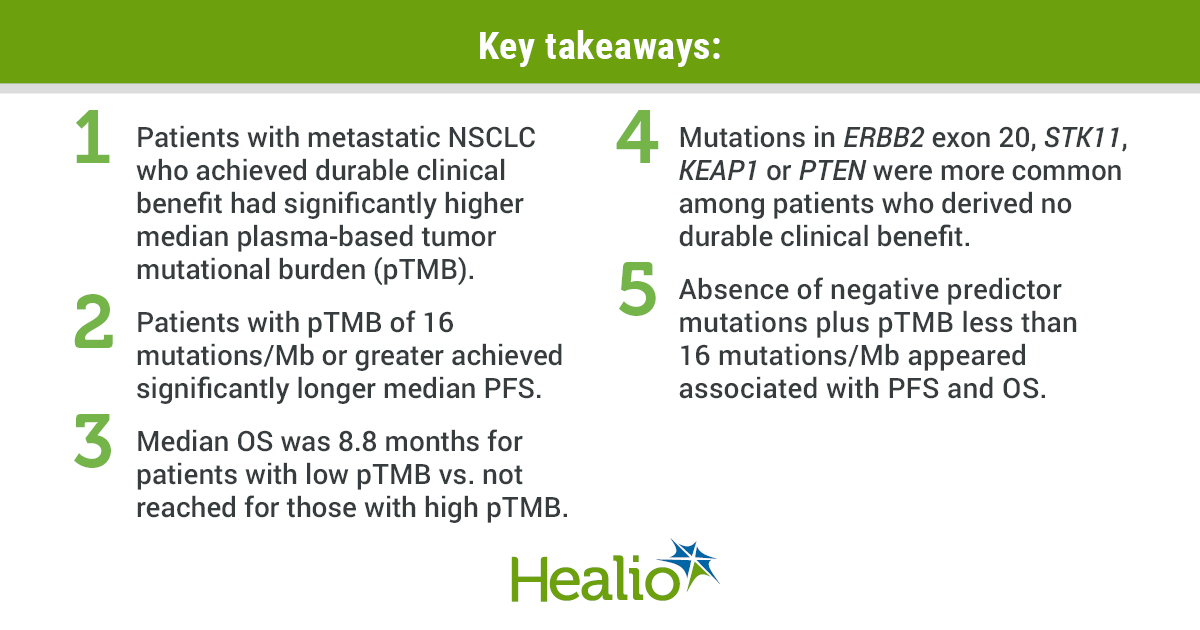Plasma tumor mutational burden linked to outcomes after initial pembrolizumab-based therapy for metastatic NSCLC

Plasma-based tumor mutational burden of 16 mutations/Mb or greater appeared associated with improved PFS after first-line pembrolizumab-based treatment for metastatic non-small cell lung cancer, according to results of a single-arm, single-center study published in Clinical Cancer Research.
Four mutations, STK11, KEAP1, PTEN and ERBB2, may help identify patients with high plasma-based tumor mutational burden (pTMB) who are unlikely to respond to treatment, researchers added.
“[Although] some people see a benefit from these therapies, unfortunately not everyone does,” Charu Aggarwal, MD, MPH, Leslye M. Heisler assistant professor for lung cancer excellence at Perelman School of Medicine at University of Pennsylvania and HemOnc Today Editorial Board Member, said in a press release. “There is an important clinical need to identify new, noninvasive biomarkers to help us guide each patient to the treatments that have the best chance of success for them, and our findings show we may now have a tool to help us do that.”
Pembrolizumab (Keytruda, Merck)-based treatment is the first-line standard of care for patients with metastatic NSCLC whose tumors lack therapeutically targetable mutations.

Tissue-based PD-L1 testing can be used to select patients for monotherapy with pembrolizumab, a PD-1 inhibitor, or pembrolizumab plus chemotherapy. However, PD-L1 is not a reliable biomarker, according to researchers, and more are needed to help in clinical decision-making.
Aggarwal and colleagues sought to evaluate associations between pTMB, measured through circulating tumor DNA, and response to first-line pembrolizumab, with or without chemotherapy, among 66 patients with newly diagnosed metastatic NSCLC.
Researchers used a 500-gene next-generation sequencing panel to assess pTMB and RECIST version 1.1 criteria to assess response, including 6-month durable clinical benefit, PFS and OS.
Among all 66 patients, 52 had evaluable pTMB.
Results showed median pTMB of 16.8 mutations/Mb (range, 1.9-52.5). Patients who achieved durable clinical benefit had significantly higher median pTMB than those who had no durable benefit (21.3 mutations/Mb vs. 12.4 mutations/Mb; P = .003).
Patients with pTMB of 16 mutations/Mb or greater had median PFS of 14.1 months compared with 4.7 months among patients with pTMB of less than 16 mutations/Mb (HR = 0.3; 95% CI, 0.16-0.6).
Median OS for patients in the high tumor mutational burden group was not reached compared with 8.8 months for patients in the low-burden group (HR = 0.48; 95% CI, 0.22-1.03).
Mutations in ERBB2 exon 20, STK11, KEAP1 or PTEN appeared more common among patients with no durable clinical benefit.
An absence of negative predictor mutations plus pTMB of less than 16 mutations/Mb appeared associated with PFS (HR = 0.24; 95% CI, 0.11-0.49) and OS (HR = 0.31; 95% CI, 0.13-0.74).
The study’s single-arm and single-center nature served as limitations.
“To our knowledge, this prospective study is the largest to correlate pTMB to outcomes after first-line standard-of-care pembrolizumab-based combination therapy in metastatic NSCLC,” Aggarwal and colleagues wrote. “Taken together, our results suggest pTMB improved the ability to predict response.” – by John DeRosier
Disclosures: The authors report no relevant financial disclosures.

